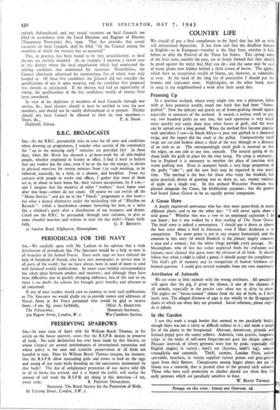COUNTRY L 1 FE
WE should all pay a final compliment to the April that has left us with still untarnished reputation. It has been said that the deadliest feature in English—as in European—weather is the May frost, whether it falls before or after the Festival of the Three Ice Saints. This spring some of the fruit trees, notably the pear, are so firmly formed that they should be proof against the worst that May can do ; and the same may be said of many plums now hidden behind a thick screen of leaves. The apples, which have an exceptional wealth of bloom, are, however, as vulnerable as ever. At the head of the long list of precocities I should put the brooms and unpruned roses. Nightingales, on the other hand, were in song in my neighbourhood a week after their usual date.
Framing Up
In a spacious orchard, where every single tree was a plutocrat, laden with at least potential wealth, stood one bush that had been " frame- grafted." Now the delicate and gentle art of frame-grafting should appeal especially to amateurs of the orchard. It sounds a serious work to put, say, two hundred grafts on one tree, but each operation is very much more quickly and easily done than other forms of graft, and the work can be spread over a long period. When the method first became popular with specialists I saw—in South Africa—a pear tree grafted in a thousand twigs, and the expert did the work at the gallop. Comparatively small twigs are cut and broken about a third of the way through to a distance of an inch or so. The correspondingly small graft is inserted so that the edges, on one side at any rate, coincide. The natural spring of the shoot holds the graft in place for the time being. No tying is necessary ; but in England it is necessary to smother the place of junction with warm grafting wax. Even in unexpert hands a very large proportion of the grafts " take " ; and the new fruit may be expected in two years' time. The method is the best for those who enjoy the freakish, but quite practical, device of growing two or three or, say, twenty varieties of apple on a single tree. In this orchard Worcester Pearmain was planted alongside the Coxes, for fertilisation purposes ; but the grower had found James Grieve to be an equally potent companion.
A Goose Hero A deeply engrooved sportsman who has shot most game-birds in many different places said to me the other day: " I will never again shoot a wild goose." Whether that was a vow or an emotional aspiration I do not know ; but it was evoked by a first reading of The Snow Goose. The brief story is indeed a masterpiece. I should put it down as almost the best story about a bird in literature, even if Hans Andersen is in competition. The snow goose is not in any respect humanised, and the emotion in this story (of which Dunkirk is the climax) largely concerns a man and a woman ; but the white wings pervade every passage. Mr. Massingham, who of late has rather neglected birds for craftsmen and farmers, once claimed that geese were the cleverest of all birds It should follow that when a child is called a goose, it should accept the compliment. The bird's gift of memory and its recognition of human kindness are beyond question. I could give several examples from my own experience.
Attributes of Animals
We are wont to libel animals with the wrong attributes. All specialists will agree that the pig, if given the chance, is one of the cleanest of all animals, especially in the precise care taken not to dirty its straw. The piglets are " house-trained " almost from the day of birth, as I have lately seen. The alleged dirtiness of pigs is due wholly to the ill-equipped slums in which too often they are prisoned. Social reformer, please copy! de to Tabula.
In the Garden I saw this week a rough border that seemed to me peculiarly bright, though there was not a rarity or difficult subject in it ; and made a rough list of the plants in the foreground. Alyssum, doronicum, primula and Iceland poppy gave the sunny yellows. Aubrietia, viola gracilis, lungwort, tulips in the midst of self-sown forget-me-not gave the deeper colours. Pleasant 'intervals of silvery greyness were lent by pinks (especially old English singles) in variety ; hare's ear (Scottice, lamb's lug), senecto rotundifolia and camomile. Thrift, catmint, London Pride; sedum spectabile, heuchera, in variety supplied various greens and grey-greens apart from their flowers. Conspicuous among bigger plants not yet in bloom was a tamarisk, that is pruned close to the ground each autumn. Those who have such protection as cloches should use them first for early potatoes which are peculiarly sensitive to frost.
W. BEACH THOMAS.
Postage on this issue : Inland and Overseas, id.


























 Previous page
Previous page